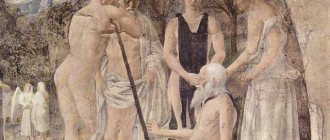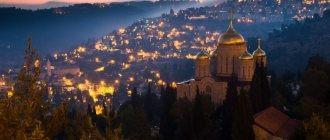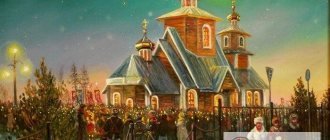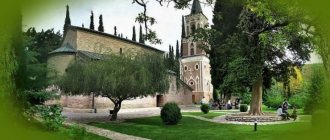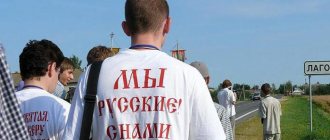There is virtually no evidence left of the early history of Jerusalem. Some information was provided by archaeological and historical research. But basically, we rely on oral traditions passed down for thousands of years and the texts of the holy books of three religions. The diversity of the city is crazy. It is very difficult to combine Orthodox Jews walking along the same street with the clergy of a Muslim temple. There are two questions in my head: how does Jerusalem combine all this? And why is he so famous? The answer to the first question can only be given by Jerusalem itself. And it is popular because it was here, according to the historical book of the Bible, that Jesus Christ himself lived and walked. It’s just an indescribable feeling, realizing this, to walk along its streets. There are several places that you can’t help but see while in the capital of Israel.
Via Dolorosa
The history of Christianity says that it was along this path that Christ walked before his crucifixion. It is believed that when Jesus walked along it, carrying a heavy cross, he stopped 9 times. Now, on each of the 9 places, there is an inscription, which indicates its short stops, even after approximately 2 thousand years have passed. But, unfortunately, this path no longer has such great value for humanity, because a tourist who wants to take a closer look at these stops will have to try very hard, due to the huge number of sellers, wanderers and student children walking along the street. Via Dolorosa has become a major market.
Jerusalem icons
There are a large number of icons of Saints in Israel. Each of them has a specific meaning and interpretation. Christians from all over the world come there to venerate and pray with them. You can also ask the priests which image would be best to purchase and buy it there in church shops.
Among the icons of the Saints of Jerusalem, the icon of the Mother of God of Bethlehem deserves special respect. It is located in the Basilica of the Nativity. She is revered not only by Christians, but also by other believers. It is customary to ask her for the gift of children, for their well-being and for the well-being of the family. You can also contact us in any need and other life circumstances. She never leaves in trouble, she becomes a Diligent Intercessor, Joy and Consolation of all people.
Remember that if possible, be sure to visit the Holy Land. This impression will remain with you for the rest of your life.
The Lord is always with you!
Church of the Holy Sepulcher
Church of the Holy Sepulcher
The end of this path is the top of a hill called Golgotha. Now it is difficult to call it a mountain, although this does not at all diminish its importance. In the time of Jesus it was much higher, but during military operations it was destroyed. Here is the most important shrine of believers in Christ - the Church of the Resurrection of Christ. This is the territory where he was crucified, buried, and where he was resurrected. In the temple there is the most famous place for tourists, where the body of Christ was removed after his death. On this stone he was prepared for the afterlife. The body was anointed with myrrh, that is, olive oil, which contains more than 40 herbs, then it was wrapped in a shroud and taken to the cave. This Christian shrine is credited with producing myrrh, so all visitors, and just visitors, lean their heads against this stone to heal. It turns out that the real stone is covered with a stone slab, which is renewed every 100 years. The Greek treasure, which is considered the most important part, is the Holy Sepulchre. It is interesting that the temple was initially not evenly divided among various denominations, which did not change until this day.
Church of the Holy Sepulcher
Wall of Tears
A place where crying and prayers are heard. Where did this name come from? The fact is that remembering the destruction of the temple that was built by King Solomon makes you cry. For the Israelis this is sadness and great grief. It is at this place that crowds of people gather for the holidays. Soldiers also take the oath here.
It is to this city that a large number of Jews, Christians and Muslims from all over the world flock in search of God. The thoughts of people all over the world are turned to this city, powerful empires laid claim to this city - this is Jerusalem, the Holy Land.
Holy Land in Jerusalem
The Holy Land is a witness to the sacred events of gospel history: the Annunciation of the Blessed Virgin Mary, the Nativity of Christ, the Presentation and Baptism of the Lord, His appearance in the Tabor Light of the Transfiguration, the Ascension of the Lord into heaven and the Descent of the Holy Spirit on the Apostles. The history of the spiritual development of mankind focused on this land and events took place that changed the natural course of history. Here the Savior of the world died on the Cross of Golgotha and, having conquered death, rose again on the third day, emerging from His tomb. Here, with the word emanating from the mouth of Christ the Messiah promised by the prophets, the despondent found comfort, the paralyzed in soul and body were healed, lepers were cleansed, the blind received their sight, the deaf heard, and the dead rose from the grave. Here the Word of God served as the seed grain for the fullness of a godly life, and a sensitive Christian soul is still able to prayerfully hear how the Holy Spirit strikes the strings of David’s Psalter.
The Holy Land is a biblical land, a special space of sacred history and sacred geography of the Old and New Testaments. This is the land where a great multitude of God’s saints shone with the light of faith: patriarchs, prophets and apostles, the first innocent martyrs for Christ and confessors, saints and a whole host of ascetics: venerable fathers and holy women. It is also the site of important events at the end of earth's history, when the last days of mankind begin.
The Holy Land, which became the cradle of the Christian faith, will forever remain dear and close to the heart of every Orthodox person.
Names of the Holy Land
This sacred land has had many names over the centuries: the Land of Canaan, the Promised Land, the Land of Israel, Palestine, the Holy Land, and is often also called the Fifth Gospel. The literal expression “Holy Land” as a place of God’s special presence is found in the Holy Scriptures of the Old Testament in the prophet Zechariah (Zechariah 2:12), in the book of Exodus (Exodus 3:5) and in two non-canonical books that reflected the popular use of this name: the book of the Wisdom of Solomon (Wis. 12:3) and the Second Book of Maccabees (2 Macc. 1:7).
One of the oldest biblical names for this land is Canaan (Heb. “Kana'an”, Judges 4:2), “Canaan, the land of the Philistines” (Zeph. 2:5), the land of Canaan, or the land of the Canaanites (Gen. 11: 31; Ex.3:17), the boundaries of which are indicated by the text of the book of Joshua (5:10-12). It says that the manna from heaven stopped falling after the people crossed the Jordan and began to eat the fruits of the land of Canaan.
In the Old Testament there are also many other names: “land of the Jews” (Gen. 40:15), “borders of Israel” (1 Sam. 11:3), “land of Israel” (1 Sam. 13:19), “land of the children of Israel.” "(Josh. 11:22) "The land of Judah" (Jer.39:10; Neh.5:14), "Judah" (Jer.3:8; 3:10; 2 Chron.35:24), "the land of the Lord "(Isa. 14:2; Hos. 9:3), or simply "earth" (Heb. Eretz). In the books of the New Testament it is called: “the land of Israel” (Matthew 2:20), “the land promised to Abraham” (Heb. 11:9), but it is emphasized that Abraham and other patriarchs were “strangers and strangers” on this land and sought the heavenly fatherland (Heb. 11:14; Heb. 11:16).
Greek writers, beginning with Herodotus, called this land Palestine (Hebrew "Philistia", literally "invading") or Syria Palestine, which corresponds to some of its biblical names in the Holy Scriptures, where "Canaan" and "land of the Philistines" are sometimes synonyms: “And Abraham lived in the land of the Philistines as a stranger for many days”
(Gen.21:34),
“Canaan, land of the Philistines”
(Zeph.2:5),
“Shout to Me, land of the Philistines!”
(2 Kings 8:2; Ps. 59:10; Isa. 14:29, etc.). However, most often the expression “land of the Philistines” refers to the coastal strip between Jaffa and Gaza, where the Philistines lived since the time of the patriarch Abraham (Gen. 21:34).
The Holy Scriptures report about this country that it abounds in God's gifts and is described as “a good and spacious land, where milk and honey flow”
(Exodus 3:8; Jeremiah 11:5), however, it is sometimes referred to as
“an empty, parched and waterless land”
(Ps.63:2).
This biblical “fat land”
(Neh. 9:25) is filled with water from the rain of heaven and is called
“a beautiful land”
(Dan. 8:9),
“a desirable land, the most beautiful inheritance of many nations”
(Jer. 3:19), and land,
“the most precious of all with You”
(Wis. 12:7).
The Holy Land was promised by God to the Old Testament patriarchs and their descendants, i.e. to the biblical people of Israel, who received it after the Exodus from Egypt. However, according to the testimony of the Holy Scriptures, it belongs exclusively to God and is called His “inheritance, inheritance” (1 Sam. 26:19; 2 Sam. 14:16) and “the land of the Lord” (Is. 14:2), and for this reason its “ You must not sell forever, for the land is Mine: you are strangers and settlers with Me”
(Lev.25:23).
For about 2000 years - from Patriarch Abraham to the times of the Gospels, this land witnessed the events of the history of the salvation of the human race. Patriarch Abraham, to whom God promised this land, lived in it as a stranger and stranger, and only the twelve tribes of Israel after the Exodus from Egypt received it as a true inheritance: “For the Lord your God is leading you to a good land, to a land where there are streams of water.” , springs and lakes come out of the valleys and mountains, into a land where there is wheat, barley, vines, fig trees and pomegranate trees, into a land where there are olive trees and honey, into a land in which you will eat your bread without want and in nothing. You will not lack."
(Deut.8:7-9).
Since ancient times, a huge number of tribes, peoples and cultures have intersected in the Promised Land: Amorites, Canaanites, Hittites, Jebusites, Perizzites, Jews, Assyrians, Philistines, Egyptians, Phoenicians, Babylonians, Persians, Greeks, Romans, Arabs, Crusaders, Mamelukes, Turks , English and many others. Ancient civilizations and many peoples whose rulers tried to take possession of this important territory by force of arms, to one degree or another left their mark on its history. The Holy Land, located at the crossroads of the great empires of antiquity, despite its tragic history, became the place where a special biblical civilization arose. On this sacred land, which had absolutely tiny dimensions from a geographical point of view, the entire depth of the Revelation of God was revealed in the events of human history of the two Testaments.
Geography of the Holy Land
The definition of the geographical boundaries of the territory of the Holy Land varies in different places of the Holy Scriptures. Its most extensive borders are given in the promise to Patriarch Abraham: “... from the river of Egypt to the great river, the river Euphrates”
(Gen. 15:18), but most often it is said that this is the “land of the Canaanites” (Exod. 3:17; Num. 34:2) and “Amorites” (Deut. 1:7), which means that part of it is included territories east of the Jordan River (Num. 32:1; Deut. 2:24; Josh. 13:8-33).
Under King Solomon, its borders extended “from the entrance to Hamath to the river of Egypt.”
(ZKi.8:65, Shar.13:5). The ancient city of Hamath was located north of Damascus, and the river of Egypt refers to the Nile. In biblical texts, the boundaries of the Promised Land are primarily defined from the city of Dan in the north to Beersheba (Heb. Beer-Sheva) in the south (2 Kings 17:11; Judges 20:1) and from the Mediterranean Sea in the west to the Jordan River in the east. The southern borders of modern Israel extend significantly beyond these boundaries.
The Holy Land occupied an important place in the history of the ancient world. Located at the center of world civilizations, it became a bridge connecting ancient Egypt and Mesopotamia, i.e. Africa and Asia. Geographically and spiritually, this territory was never closed and was in constant contact with Arabia and Mesopotamia, through Iran (Persia) it communicated with India, through Egypt and Nubia - with Africa, and also through Asia Minor and the Mediterranean islands - with Europe. The Holy Land was of strategic importance as a network of important land and sea routes, but they were often dependent on their more powerful neighbors. Its coastal strip and the Jezreel Valley were crossed by caravan trade routes, including the so-called. The Sea Route (Latin Via Maris literally - “road of the sea”) connected Egypt and the northern states of Syria, Anatolia and Mesopotamia.
In the prophetic vision, this country is likened to a well-fenced and protected vineyard (Isa. 5:1). Its sea shores were devoid of good harbors, and the Jordan, the only navigable river, was impossible to navigate either by ship or by sailing vessel. The chosen people lived here, in the words of the prophet Ezekiel, “on the top of the earth”
(Eze. 38:12), and Jerusalem in the historical sense was placed “
among the nations” (
Eze. 5:5) V so that when the time is fulfilled, the word of salvation, starting from Jerusalem, could spread to all parts of the world and
“even to the ends of the earth”
(Isa. 2:3; Acts 1:8).
